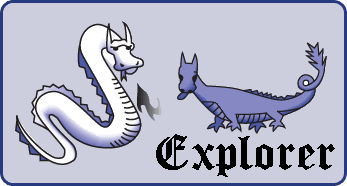|
|
| |||||||||||||||||||||||||||||||||||||||||||||||||||||||||||||||||||||||||||||||||||||||||||||||||||||||||||||||||||||||||||||||||||||||||||||||||||||||||||||||||||||||||||||||||||||||||||||||||||||||||||||
 |
 |
There are four pairs of linked genes in Syrians known at this time. The X-Linked Yellow; Banded & Hair Length; C-locus & Cinnamon; Umbrous & Satin. For information on Yellow inheritance go to X-Linked below. The other 3 linked sets can recombine but with varying degrees of success.
Let's begin with Banded and Long Hair, since those genes are usually available and easier to understand. Banding is a dominant gene that only requires one gene to express it's phenotype. So BaBa and Baba will both produce a banded hamster. BaBa is called homozygous and Baba is heterozygous. Long Hair is a recessive gene. This means it has to be homozygous ll to express it's phenotype (physical appearance).
We'll start with a Homozygous Banded & Short Haired BaBa LL hamster mated to a Solid Long Haired baba ll hamster. All offspring will be Banded carrying a gene for Long Hair Baba Ll. Now we'll mate one of the offspring to the Long Haired baba ll hamster. You would expect the Punnet square to look like this:
| Grandparent/ Parent baba ll Long Haired |
Grandparents are BaBa LL (Banded) and baba ll (Long Hair) | ||||
| Parent Baba Ll Banded carrying Long Hair | |||||
| Ba L | ba l | Ba l | ba L | ||
| ba l | Baba Ll Heterozygous Banded carrying Long Hair |
baba ll Golden Long Hair |
Baba ll Heterozygous Banded Long Hair |
baba Ll Golden carrying Long Hair |
|
You would get one of each genotype and phenotype. However these genes are so close to each other they usually get inherited as a pair instead of individually. The ratio is roughly 9:1 for Parental type to Recombined type. So the actual outcome of this mating would be more like this:
| Grandparent/ Parent bal/bal Long Haired |
Grandparents are BaL/BaL (Banded) and bal/bal (Long Hair) | ||||
| Parent BaL/bal Banded carrying Long Hair | |||||
| 9 BaL | 9 bal | Bal | baL | ||
| bal | 9 BaL/bal Heterozygous Banded carrying Long Hair |
9 bal/bal Solid Long Hair |
Bal/bal Heterozygous Banded Long Hair |
baL/bal Solid carrying Long Hair |
|
As you can see it is possible to get a cross-over but more difficult then the normal genetic pairings. You would get 9 Banded Short HairedBaL/bal, 9 Solid Long Hairedbal/bal, 1 Banded Long HairedBal/bal, and 1 Solid Short HairedbaL/bal. You'll notice that the parental genes are listed as BaL/bal instead of Baba Ll. This is used with linked genes to signify the link between the two genes from the parents. I've used different colors for the original parental linked genes (BaL and bal) and the recombined parental linked genes (Bal and baL) to show where the new linked pairs are. The above chart is a short one for Banded and Long Hair. Below is a sibling pairing.
| Grandparents are BaL/BaL (Banded) and bal/bal (Long Hair) | |||||
| Parents are Siblings | Parent BaL/bal Banded carrying Long Hair | ||||
| 9 BaL | 9 bal | Bal | baL | ||
| Parent BaL/bal Heterozygous Banded carrying Long Hair |
9 BaL | 81 BaL/BaL Homozygous Banded |
81 BaL/bal Heterozygous Banded carrying Long Hair |
9 BaL/Bal Homozygous Banded carrying Long Hair |
9 BaL/baL Heterozygous Banded |
| 9 bal | 81 BaL/bal Heterozygous Banded carrying Long Hair |
81 bal/bal Solid Long Hair |
9 Bal/bal Heterozygous Banded Long Hair |
9 baL/bal Solid carrying Long Hair |
|
| Bal | 9 BaL/Bal Homozygous Banded carrying Long Hair |
9 Bal/bal Heterozygous Banded Long Hair |
Bal/Bal Homozygous Banded Long Hair |
Bal/baL Heterozygous Banded carrying Long Hair |
|
| baL | 9 BaL/baL Heterozygous Banded |
9 baL/bal Solid carrying Long Hair |
Bal/baL Heterozygous Banded carrying Long Hair |
baL/baL Solid Short Haired |
|
As you can see it is possible to get some recombining but more difficult then the normal genetic pairings. You would get the following phenotypes and genotypes:
The next linkage is with two recessive genes - C-locus and Cinnamon. There are currently 3 alleles for the Syrian C-locus: C is full color; cd is Dark Eared White; ce is Extreme Dilute. The linkage works the same for any allele on the C-locus since it is the location not the gene that causes the linkage. For this example I'll use the Dark Eared White (DEW).
| Grandparents are cep/cep (Pale Eared White or PEW) and CP/CP (Golden) | |||||
| Parents are Siblings | Parent CP/cep Golden carrying DEW & Cinnamon | ||||
| 2 CP | 2 cep | Cp | ceP | ||
| Parent CP/cep Golden carrying DEW & Cinnamon |
2 CP | 4 CP/CP Golden |
4 CP/cep Golden carrying DEW & Cinnamon |
2 CP/Cp Golden carrying Cinnamon |
2 CP/ceP Golden carrying DEW |
| 2 cep | 4 CP/cep Golden carrying DEW & Cinnamon |
4 cep/cep FEW |
2 Cp/cep Cinnamon carrying DEW |
2 ceP/cep DEW carrying Cinnamon |
|
| Cp | 2 CP/Cp Golden carrying Cinnamon |
2 Cp/cep Cinnamon carrying DEW |
Cp/Cp Cinnamon |
Cp/ceP Golden carrying DEW & Cinnamon |
|
| ceP | 2 CP/ceP Golden carrying DEW |
2 ceP/cep DEW carrying Cinnamon |
Cp/ceP Golden carrying DEW & Cinnamon |
ceP/ceP DEW |
|
Phenotypes and genotypes will be:
The last known linkage for Syrians is Satin and Umbrous. Both are dominant genes so there only needs to be one gene to express that phenotype. The ratio is also higher then the other two. This means it's less likely the parental genes will recombine.
| Grandparents are SaU/SaU (Homozygous for Satin & Umbrous) and sau/sau (Golden) | |||||
| Parents are Siblings | Parent SaU/sau Heterozygous Satin & Umbrous | ||||
| 16 SaU | 16 sau | Sau | saU | ||
| Parent SaU/sau Heterozygous Satin & Umbrous |
16 SaU | 256 SaU/SaU Homozygous Satin & Umbrous |
256 SaU/sau Heterozygous Satin & Umbrous |
16 SaU/Sau Homozygous Satin & Heterozygous Umbrous |
16 SaU/saU Heterozygous Satin & Homozygous Umbrous |
| 16 sau | 256 SaU/sau Heterozygous Satin & Umbrous |
256 sau/sau Golden |
16 Sau/sau Heterozygous Satin |
16 saU/saU Heterozygous Umbrous |
|
| Sau | 16 SaU/Sau Homozygous Satin & Heterozygous Umbrous |
16 Sau/sau Heterozygous Satin |
Sau/Sau Homozygous Satin |
Sau/saU Heterozygous Satin & Umbrous |
|
| saU | 16 SaU/saU Heterozygous Satin & Homozygous Umbrous |
16 saU/sau Heterozygous Umbrous |
Sau/saU Heterozygous Satin & Umbrous |
saU/saU Homozygous Umbrous |
|
Phenotypes and genotypes will be:
As you can see it is much more difficult to get recombining with this pair especially since 1156 animals would have to be produced to reach these ratios.
If you think this last square had high numbers there is a gene pair in rabbits that has a ratio of 600:1.
Normal females are XX and normal males are XY. The X chromosome is thought to be the primary chromosome from when we were one-celled creatures and didn't have two sexes. The Y chromosome is a truncated X chromosome and carries little genetic information other then maleness. For this reason the recombination that occurs with other linked genes does not happen with X-linked genes. A female that is X0 (only one X chromosome) will have all of the required traits of a female the same as a normal female. So only one X is required in females. Because of this a phenomenon called X-inactivation occurs. One of the two Xsbasically shrivels up and becomes inactive. This happens early in embryonic development. The embryo grows and more cells are produced from the cells that now have only one active X. These are daughter cells. When there is an X-linked gene it's possible to inherit two different alleles, one from each parent. This is the basis for the Tortoiseshell pattern. The female hamster inherits a Yellow gene from one parent and a non-Yellow from the other parent on her two X chromosomes. The size of the patterns depends on how early the X-inactivation occurs. Rarely more then one ova and one sperm join together or the splitting for the ova and/or sperm doesn't happen like it should. Since a male normally has only one X they can only be Yellow ToY or non-Yellow toY. Females can be Yellow ToTo, non-Yellow toto, or Tortoiseshell Toto. Below are four Punnet squares showing only yellow. Of course if you breed two Goldens together you'll get all Goldens. And two Yellows will give you all Yellows. This is assuming there are no recessives lurking in the gene pool. For a more in depth series of Punnet squares on Tortoiseshells go here. Most people put the Y in for the males to designate there are two genes but only the X can be Yellow.
| Yellow Father ToY | |||
| To | Y | ||
| Golden Mother toto |
to | Toto Golden Tort girl |
toY Golden boy |
| to | Toto Golden Tort girl |
toY Golden boy |
|
| Yellow Father ToY | |||
| To | Y | ||
| Golden Tort Mother Toto |
To | ToTo Yellow girl |
ToY Yellow boy |
| to | Toto Golden Tort girl |
toY Golden boy |
|
| Golden Father toY | |||
| to | Y | ||
| Yellow Mother ToTo |
To | Toto Golden Tort girl |
ToY Yellow boy |
| To | Toto Golden Tort girl |
ToY Yellow boy |
|
| Golden Father toY | |||
| to | Y | ||
| Golden Tort Mother Toto |
To | Toto Golden Tort girl |
ToY Yellow boy |
| to | toto Golden girl |
toY Golden boy |
|
| ||||||||||||||||||||||||||||||||||||||||